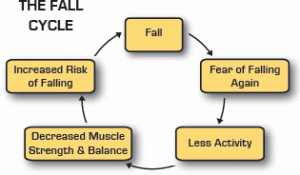Falls Prevention
Written by Lindsay Cartwright
Falls Prevention
Why falling is a problem:
Falling can lead to a wide variety of injuries including: head injuries, fractures of the wrist, spine, and hip. It is important for people of all ages and abilities to make efforts to avoid falling, especially as the winter approaches.
Older adults need to be aware of the risks they face. Statistics show that seniors who fall are at three times the risk of being permanently institutionalised than those who do not fall. (http://www.veterans.gc.ca/eng/services/health/promotion/fallsp/factsheets)
It has been theorised that when someone falls once, they are at a greater risk of falling again in the future because they enter “The Fall Cycle” (see diagram below). This is a vicious cycle that causes an individual to fear falling after experiencing a fall, therefore avoiding certain activities and becoming less physically active. With less activity, they risk losing muscle mass, balance, and bone density, which means they are at a greater risk of falling yet again, and will likely face more serious consequences.

Image from: http://www.everybody.co.nz/page-d20bdbe8-13d1-472a-aecb-fd12a0ea11b8.aspx
Ways to prevent falls:
Physical activity is imperative for preventing disease and illness. People who exercise regularly are able to gain and maintain muscle strength and endurance, balance, and bone density. For more of the general information on the benefits of physical activity, check out our previous blog post!
As the winter months approach it is easy to stay inside where it’s warm, but it is especially important to stay active since there are more falling hazards with snow and ice. There are lots of ways to continue (or start) exercising during the winter!
Here are a few you can try:
• Walking at an indoor walking track (like the one at Alder Street Arena)
• Try a class, like Tai Chi- you can find these at your local recreation centre and seniors centre
• Other fitness classes like yoga and zumba are great too!
• If you would rather stay home, try out a workout from a Youtube video
• There are even beginner and advanced fitness classes right here at Healthwise Physiotherapy! We cater to all abilities and encourage everyone to try it out. For more information you can contact us at [email protected] or 519-942-8884 or check out more information on our website.
There are other precautions that should be taken, particularly for older adults who may be at a greater risk of falling. Wearing proper footwear for the conditions is a great first step. Shoes or boots with deep tread and good grip is important for snowy and icy conditions. If assistive devices like a cane or crutches are used ice grippers for the ends are helpful. You can also purchase ice grippers that fit over shoes and boots. It is always a good idea to plan ahead. Choose the safest route with sidewalks that are cleared of snow regularly. Sand and salt can make slippery surfaces safer. Keep a baggy in your pocket in case you encounter an unavoidable patch of ice. Kitty litter works great too!
Take small steps, walk slowly and pay attention. Be aware of other pedestrians and traffic around you. Walk with a group or a friend for extra safety.
Other tips:
• Wear sunglasses on bright days
• Do not wear reading glasses when walking
• Talk to your doctor about medications that you take. Some have side effects that can impair balance
• Make sure you are getting proper nutrients. Calcium is important for keeping bones strong and protein is needed to maintain muscle mass
Bonus:
Staying active can help mental health too. Exercising in a group or with friends is a great way to socialize and beat the winter blues!

